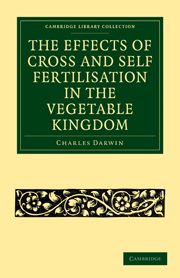Book contents
- Frontmatter
- Contents
- CHAPTER I INTRODUCTORY REMARKS
- CHAPTER II CONVOLVULACEÆ
- CHAPTER III SCROPHULARIACEÆ, GESNERIACEÆ, LABIATÆ, ETC
- IV CRUCIFERÆ, PAPAVERACEÆ, RESEDACEÆ, ETC
- CHAPTER V GERANIACEÆ, LEGUMINOSÆ, ONAGRACEÆ, ETC
- CHAPTER VI SOLANACEÆ PRIMULACEÆ, POLYGONEÆ, ETC
- CHAPTER VII SUMMARY OF THE HEIGHTS AND WEIGHTS OF THE CROSSED AND SELF-FERTILISED PLANTS
- CHAPTER VIII DIFFERENCE BETWEEN CROSSED AND SELF-FERTILISED PLANTS IN CONSTITUTIONAL VIGOUR AND IN OTHER RESPECTS
- CHAPTER IX THE EFFECTS OF CROSS-FERTILISATION AND SELF-FERTILISATION ON THE PRODUCTION OF SEEDS
- CHAPTER X MEANS OF FERTILISATION
- CHAPTER XI THE HABITS OF INSECTS IN RELATION TO THE FERTILISATION OF FLOWERS
- CHAPTER XII GENERAL RESULTS
- INDEX
CHAPTER VII - SUMMARY OF THE HEIGHTS AND WEIGHTS OF THE CROSSED AND SELF-FERTILISED PLANTS
Published online by Cambridge University Press: 29 August 2010
- Frontmatter
- Contents
- CHAPTER I INTRODUCTORY REMARKS
- CHAPTER II CONVOLVULACEÆ
- CHAPTER III SCROPHULARIACEÆ, GESNERIACEÆ, LABIATÆ, ETC
- IV CRUCIFERÆ, PAPAVERACEÆ, RESEDACEÆ, ETC
- CHAPTER V GERANIACEÆ, LEGUMINOSÆ, ONAGRACEÆ, ETC
- CHAPTER VI SOLANACEÆ PRIMULACEÆ, POLYGONEÆ, ETC
- CHAPTER VII SUMMARY OF THE HEIGHTS AND WEIGHTS OF THE CROSSED AND SELF-FERTILISED PLANTS
- CHAPTER VIII DIFFERENCE BETWEEN CROSSED AND SELF-FERTILISED PLANTS IN CONSTITUTIONAL VIGOUR AND IN OTHER RESPECTS
- CHAPTER IX THE EFFECTS OF CROSS-FERTILISATION AND SELF-FERTILISATION ON THE PRODUCTION OF SEEDS
- CHAPTER X MEANS OF FERTILISATION
- CHAPTER XI THE HABITS OF INSECTS IN RELATION TO THE FERTILISATION OF FLOWERS
- CHAPTER XII GENERAL RESULTS
- INDEX
Summary
The details which have been given under the head of each species are so numerous and so intricate, that it is necessary to tabulate the results. In Table A, the number of plants of each kind which were raised from a cross between two individuals of the same stock and from self-fertilised seeds, together with their mean or average heights, are given. In the right-hand column, the mean height of the crossed to that of the self-fertilised plants, the former being taken as 100, is shown. To make this clear, it may be advisable to give an example. In the first generation of Iponioea, six plants derived from a cross between two plants were measured, and their mean height is 86·00 inches; six plants derived from flowers on the same parent-plant fertilised with their own pollen were measured, and their mean height is 65·66 inches.
From this it follows, as shown in the right-hand column, that if the mean height of the crossed plants be taken as 100, that of the self-fertilised plants is 76. The same plan is followed with all the other species.
The crossed and self-fertilised plants were generally grown in pots in competition with one another, and always under as closely similar conditions as could be attained. They were, however, sometimes grown in separate rows in the open ground. With several of the species, the crossed plants were again crossed, and the self-fertilised plants again self-fertilised, and thus successive generations were raised and measured, as may be seen in Table A. Owing to this manner of proceeding, the crossed plants became in the later generations more or less closely inter-related.
- Type
- Chapter
- Information
- Publisher: Cambridge University PressPrint publication year: 2009First published in: 1876



